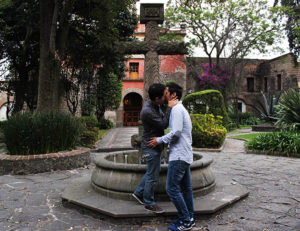My name is Arianna, I live in Mexico, which is a very catholic country (89.3% of the population were catholic in 2010, according to INEGI).
As we know, the catholic church doesn’t approve of homosexuality, so for the first assignment I came up with the idea of bringing a gay couple to church and ask them to take hands, hug, and show other forms of affection, to see what the social reactions would be.
Social response:
People kept looking at the couple posing and me taking the photographs. But nobody told us anything, as I thought it would happen. This may be because there wasn’t a mass at the moment we took the pictures, and people didn’t felt they had a reason to tell us something about it. I also think it has to do with the fact that I live in Mexico City, where people are a little bit more open or at least more used to homosexuality.
Efforts to conduct the event:
I asked a lot of gay friends to help me with this project, but only 1 couple agreed. Many of them didn’t feel comfortable going to church or for example kissing in front of catholic believers.
Even when I talked about my project with other people I got some responses like “that’s heresy”.
For the photographs I chose specific places like the altar for the couple to place themselves to make allusion to the way heterosexual couples get married. I also chose a classic style’ church in a very conservative neighborhood to make more of a contrast.
Topics related to the project:
1. Public Art
This was made inside a church at Mexico City. Is this a public art project? Well, a church is technically not public, but anyone can go inside, it is open to the public. For this reason we also didn’t know what to expect, they could ask us to not take photographs or even could have kicked us out.
2. Contested nature
This project has a contested nature, just like the monuments mentioned in the lecture, the actions made and also the people themselves are controversial and contest the ideology related to the place.
3. Politics
The project also has to do with political issues. Since june of this year, gay marriage is legal in all of the states of Mexico, but the reason this took so long was the opposition from the conservative groups of society, whom in most cases are directly related to the catholic church.
This is also my way of going against this kind of discrimination.
4. Ephemeral art
This was an ephemeral art project, a happening or a short event, like most art that has to do with people, such as performances.
5. Individual intervening in public space
In this case it wasn’t an object that was placed in a public space, but people (who are not accepted there) are interacting in it.
6. Public
The audience of this project were the people attending to church. And now, the people who will look at the photographs online. I believe this last thing is quite interesting, the internet opens a whole new world of possibilities in terms of audiences and reactions.
(In the future I would like to repeat this project, with more couples and maybe on a time of the day in which more people attend to church; unfortunately this time it wasn’t possible because of the couple’s schedule).
This is one of the comments I got in the feedback at the Coursera platform that I find very interesting:
“The tension in this photo performance is jarring. The juxtaposition between religions ‘public’ space and the same-sex relationship that was long forced to be ‘private,’ away from the public sphere is provocative. The photo of the couple in darkness before a religious statue is particularly symbolic. With bars between the two men and the representation of what looks to be Jesus, we are forced to question who is behind bars. Is it the couple because they are unable to be themselves in society for so long, or is it the church as represented by the son of God that refuses to recognizes modern ideas? I am a huge fan of this work”.








One Reply to “Love and Catholicism in Mexico”
Comments are closed.